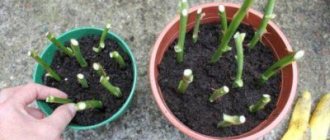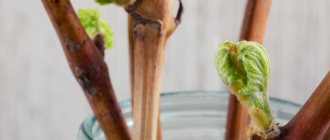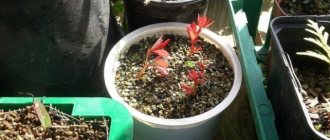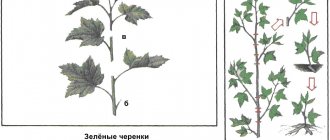- October 17, 2019
- Flowers
- Efimova Anastasia
A bouquet of flowers is a wonderful, but, alas, short-lived gift. Even the youngest buds lose their freshness after just a few days. Many people want to give cut roses a second life and try to root them. Most often it is unsuccessful, since the process of forming new roots requires special conditions.
And yet you can grow a rose from a bouquet at home. You just need to carefully follow the instructions, and everything will work out!
What flowers can be used for cuttings
Experienced gardeners know well how to grow a rose from a bouquet. Skills and abilities are acquired through many years of experimentation with different varieties of flowers. But for an amateur, this process can be difficult.
The fact is that theoretically you can work with any of the purchased roses. How to grow a rose in practice is a completely different matter. Flower growers know that winter flowers take root worse than summer ones. And at home, local varieties will take root faster than imported bushes.
For 100% success, you need to choose flowers grown in your region, cut in May-June, and not treated with chemicals. It is also worth remembering that hybrid and grafted bushes often grow roses that are completely different from the parent flower. You can experiment with non-native flowers at any time of year. But in this case, the chance of failure increases significantly.
Preparation of cuttings
To grow roses from a bouquet, you need to select the right cuttings. This is the most important stage of preparation and should not be neglected. Flower growers often argue about which stems to take - fresh, on the day of purchase, or already standing and withered. Both cases have their own arguments and chances of success. In the first option, the cuttings are used immediately, in the second, the dried sections on the stems need to be trimmed and the cuttings placed in cold water for a couple of hours.
But by and large, the only thing that matters is what the stem looks like. It should be strong, healthy, without signs of decay and at the initial stage of lignification. Young flexible green shoots have not yet gained strength for growth. Completely brown hard ones germinate poorly and often rot.
Cuttings of roses from a bouquet are carried out only with a sharp instrument - a knife or pruning shears. A dull blade unnecessarily crushes and injures the plant. It is also important to treat all tools and planting containers from bacteria. To do this, just pour boiling water over the equipment or wash it with soapy water.
Timing of cuttings
The specific timing depends on the climate in the region, the variety of flowers and the formation of rose shoots. In summer, this procedure can be performed twice. The best time is considered to be the middle of the warm season, which occurs at the end of June - beginning of July.
In addition, cuttings of roses are very often carried out in the autumn. Why? At this time, the bushes are pruned. After this procedure, cut stems remain, which can be used for spring planting. The cuttings are prepared as follows: the thorns and leaves are removed, and the sections are sealed with paraffin. Seedlings are stored in a cool place; cellars and basements are excellent for this.
Step-by-step instructions for cutting roses
Select the strongest and healthiest flowers from the bouquet. The idea is to cut off all the buds on them.
Cut the stem into cuttings - each 20-25 cm long. An oblique cut is made at the bottom of the stem to increase the absorption surface. As a rule, the cut starts 1-2 cm from the lower bud. A straight cut is made from above - a couple of centimeters from the upper bud. Thus, each leaf must have at least two buds (growth points). Prepare the required number of cuttings.
Remove all lower leaves. Cut the top ones by 1/3. This will reduce moisture loss. There is no need to remove all the leaves. But the spikes can be sacrificed.
Prepare a container with clean, settled water. You need to add a couple of drops of growth stimulants to it. Dip the cuttings about a third into the liquid (with an oblique cut down) and wait 6 hours.
Root flowers in any convenient way. There are several of them, and to achieve a positive result it is worth using at least 2-3. Therefore, cuttings should be prepared with a reserve - most of them will not take root, but the remaining ones will pleasantly please.
How to cut correctly
It should be noted that an important factor for the successful rooting of cuttings is the correctness of their pruning. So, according to all gardeners, the best options for objects for cuttings are only healthy, saturated sprouts with at least 3-5 developed buds.
In order for the roses to grow, you need to make the right cuts - straight on top and oblique on the bottom. To perform this action, you should use only well-sharpened garden tools, previously disinfected with alcohol and rinsed with water.
Speaking about the peculiarities of making cuts in cuttings, it should be noted that the lower cut, which will subsequently be immersed in the ground, should be made immediately under the lower developed bud, and the upper one - 2-3 cm above the upper bud.
Experienced gardeners also do not recommend tearing off all the leaves from the cuttings, leaving a few so that the branch is provided with the appropriate amount of nutrition. This rule does not apply to the lower leaves - they must be removed completely.
Growth stimulants
How to root a rose from a bouquet? At home, many novice gardeners neglect the achievements of modern chemistry, and completely in vain. Growth stimulants activate root growth, the bush will take root faster and will not hurt for a long time.
You can prepare growth stimulants yourself - from water and honey (a teaspoon per liter of water) or aloe juice with water in a ratio of 1:10.
You can also buy them in the store. The drugs “Kornevin”, “Radifarm”, “Zircon”, “Epin extra” are very popular (use according to the instructions on the package).
How to grow a rose? We prepared cuttings from the cut flower, now comes the stage of root germination.
Germinating cuttings in water
This is the most common way. Even amateurs and newcomers to the flower world are familiar with it. And all of them, when asked how to grow a rose from a bouquet, will answer that you need to put the cut stem in water.
For this method, the most important step is the selection of water. Rain or settled filtered tap water works well. But melt water, especially from dirty urban snow, is of little use.
Water needs to be poured into a clean container and the cuttings placed in it. Then they should be placed in a place where there is no direct sunlight. Change the water every couple of days and at the same time inspect the stems for signs of rot.
Some gardeners add universal complex fertilizers to the water. This way roots form faster. However, you should not overuse the quantity and make a solution that is too concentrated, which will burn all living cells.
In potatoes
How to grow roses? Cuttings from a bouquet need to be stuck into potatoes - this unconventional planting method is being practiced by more and more flower growers. Potato tubers are a perfectly balanced medium of liquid and starchy substances, and it is ideal for root germination.
For rooting, you need to choose good tubers - medium-sized, strong, without signs of sagging or rot. The potatoes are thoroughly washed and placed in a pink solution of potassium permanganate for disinfection. Then they dry and cut out a recess corresponding to the diameter of the stem. It doesn't have to be cross-cutting.
A cutting is placed in the hole and the tuber is buried in a pot with soil, watered and covered with a transparent plastic bottle to create a greenhouse. After the first shoots appear, the seedling needs to be ventilated at least once a day.
Some gardeners, after the roots appear, break the potatoes and replant the plant in the ground. Others prefer to leave the tuber as a natural fertilizer.
Burrito method
An interesting way to grow a rose from a bouquet. I think there is no need to explain what a burrito looks like. But just in case, it's a tightly rolled Mexican tortilla, often filled with vegetables and meat. In this case, the “filling” will be the stalk, and the damp newspaper will play the role of the cake.
Thick cuttings should be sprinkled with a growth stimulator and wrapped in damp newspaper. At the same time, the paper should not leak, but in general you can experiment with the amount of water and select different options. Then the “burrito” is placed in a plastic bag and a place with a constant temperature of 18-20 ⁰C.
Once a week, the paper needs to be unrolled and checked for rot. After some time, growths appear on the cut areas. This is a sure sign that it is time to move the plant into the ground.
In the package
Roses taken from bouquet cuttings are often grown in bags. This is a rather interesting technology in which there is no need to select additional containers for planting.
Germination of roses in bags is carried out as follows:
- Fill the bag with soil suitable for roses to about a third of the total volume.
- Moisten the cut of the cutting with a growth stimulator.
- Fill the remaining volume of the bag with air and tie the container at the very top.
Roses in bags are grown in a suspended state, on the sunny side of the house, for example, near a south or east window. The first shoots should appear in a couple of weeks. After 2-3 months, the plant can be transplanted into the ground to a permanent place.
How to plant a rose cutting correctly
The next stage is planting in the ground. However, if the cuttings of the rose took place in the fall and a simple method of propagation in a pot was chosen, then the plant can simply be left there, providing it with appropriate care, that is, a sufficient amount of light, regular watering and spraying.
If the grower has chosen a different option, then 2-3 weeks after the start of germination, the plants need to be planted in the ground. Store-bought is best - nutritious, light. But you can do it yourself by mixing sand, black soil and compost in equal proportions.
First roots on seedlings
A hole is dug in the pot, slightly larger than the root system of the seedling. The plant goes down there and the hole is filled with soil. This must be done carefully so that the roots are not damaged and quickly begin to take root in the new place.
Germination in soil
Is it possible to get a bush directly in the ground from a cut flower? Many people know how to grow a rose in the ground. But will the cutting take root if it is immediately planted in the ground? Experienced flower growers claim that this is the most difficult germination method, but at the same time the most effective.
For cuttings you need to choose a pot. If you need to plant each stem in an individual container, then buy 0.5 liter containers. Medium in height and width. But often this is impractical, since some of the cuttings die. Therefore, many gardeners plant several plants in one large pot. In this case, you need to take a larger container, proportional to the number of plants.
Step-by-step instructions for planting cuttings in a pot
The instructions are:
- Treat containers and tools with a pink solution of potassium permanganate. This will avoid plant death from fungal and bacterial infections.
- Place 3-5 cm of drainage on the bottom of the container - gravel, crushed stone, broken shards. Can be replaced with pieces of polystyrene foam. For disinfection, drainage is poured with boiling water or washed with a solution of potassium permanganate.
- Place suitable soil in the pot, compact it slightly, but do not compact it. A soil mixture suitable for roses can be purchased at the store. Or you can prepare it yourself from two parts of ordinary garden soil and one part of sand. Before use, the soil must be fried on a baking sheet for disinfection.
- Make a small depression (you can use your finger), plant the cutting and sprinkle it with soil. If there is more than one seedling, then they need to be evenly distributed over the entire surface of the soil, so that there is 5-6 cm between two plants.
- Water. Slightly cool, well-settled water or rainwater.
- Create a greenhouse effect. To do this, you need to cover the entire pot with film (you can use food film). Or cover each seedling with a cut plastic bottle or disposable cup.
- The seedlings are watered as needed. To avoid washing away the roots, it is better to do this with a sprayer.
- The plants are ventilated once a day. The first sessions last 3-5 minutes. Every day, as they heal, their duration needs to be increased. As soon as the first green leaves appear, the improvised greenhouse can be removed.
How to propagate a flower in an apartment by cuttings?
Inventory and materials
- Sharp garden pruning shears, pre-disinfected with manganese or alcohol solution.
- Pots or plastic containers. The pot must have drainage or drain holes so that the watered soil does not retain moisture, as the cutting may rot.
- Covering material: glass jars, cut plastic bottles, plastic film.
Preparing the soil and pots
The rose cuttings need to be rooted in loose, fertile soil. You can root roses in plastic containers or buckets, in wooden boxes and in flower pots.
Important! The soil should be nutritious and well-drained. It is prepared from 2 parts of turf soil, 1 part of clean river sand and 1 part of humus or peat.
Drainage is placed at the bottom of prepared containers, then prepared soil is poured in and another 3 cm of sand is poured on top for better air circulation. Sand prevents the formation of a crust on the surface of the earth.
Before planting the cuttings, the soil must be spilled with a solution of Fitosporin or potassium permanganate for disinfection. The drug Glyokladin is also used, which prevents the formation of root rot. It is enough to bury just 1 tablet of this drug 2 cm into the soil.
Cutting planting material
- To make a cutting, you must first remove the lower leaves.
- You should leave 3 buds on the cutting.
- Under the first lower bud, step back 2 cm and make an oblique cut (an oblique cut is made to obtain a larger rooting area, and also to avoid confusing the top and bottom).
- From the top of the cutting above the third bud, retreat 1 cm and make a straight cut. The cut must be made with a sharp knife or pruning shears, previously disinfected in potassium permanganate or an alcohol solution.
Cuttings should not be broken off or left with a torn edge. It is not recommended to trim with scissors, as they will only crush the fibers of the stem. The top leaves should be left, they will show whether the cutting has taken root or not. The trimmed cuttings must be carefully inspected to ensure that there is no damage or pests. The stems should be no thinner than 4mm and no thicker than 6mm. The length of the cutting should be 17-20cm.
Processing the top and bottom of the cut
Important! Before planting, the lower part of the cutting must be treated with stimulants for the formation and growth of roots.
Kornevin is suitable for this, in which the lower cut is dipped and immediately planted in the ground. You can hold the bottom of the cuttings in a solution of Heteroauxin (5 mg per 100 ml of water) or Zircon (5 drops per 1 liter of water).
Good results are obtained by soaking in a honey solution; for this, 1 teaspoon of honey is diluted in a glass of water. Aloe juice is also a natural stimulant. All stimulants are left for 24 hours. The top of the cut can be dipped in wax to prevent rotting. The thorns need to be removed.
How to plant?
After the rose cuttings have been processed, you can plant them in prepared containers. The container should be deep and spacious enough.
- At the bottom of the container you need to put expanded clay or pebbles in a layer of 5 cm.
- Pour the prepared soil, adding perlite or vermiculite to it for looseness and moisture retention. You can mix the prepared soil with rose mixture purchased at the garden center. It is useful to add sphagnum moss to the mixture. It has a beneficial effect on the rooting process and prevents the cuttings from rotting.
- Using a spray bottle, lightly moisten the soil.
- Make vertical holes with a stick at a distance of 9-10cm from each other.
- Dip the lower cut of the cutting in water and Kornevin and insert it into the holes so that the cutting does not reach the drainage layer. The second and third buds should be above ground level in the pot or planting container. The cuttings need to be planted at a slight angle; it is believed that this will allow rooting to take place better. Kornevin will promote active root growth. Compact the soil well around the planted cuttings and water a little with manganese solution.
How to root?
For reliable rooting, planted rose cuttings need to create high air humidity - 80-90%. To do this, each cutting is covered with a cut plastic bottle or a common greenhouse is made. The top leaves remaining on the cuttings should not touch the shelter. This creates a microclimate for rapid root formation.
The plastic bottles used to cover the cuttings must be transparent. If you take a large container for germination, then it is better to build a greenhouse over it, that is, cover the box with polyethylene.
For the first 20 days, to maintain moisture, the plants and soil must be sprayed every 3 days. It is recommended to ventilate in the morning and evening. Do not allow strong condensation to form, as the cutting may rot. Rooted cuttings should be kept in a warm and bright place.
Make sure that the containers with planting material are not exposed to direct sunlight, as the branches may get burned.
Advice! To prevent rot, you can periodically water the soil with a solution of Fitosporin (1 teaspoon per 1 liter of water).
After another 3 weeks, the microclimate created in the greenhouse must be changed. Containers with cuttings are transferred to the balcony or lowered into the basement for winter storage. The air temperature should be +2-+3 degrees, humidity 60-70%. If the temperature on the balcony becomes lower, the greenhouse must be covered with a blanket.
Some gardeners use potatoes to root rose cuttings. Tubers contain many useful substances and are a source of moisture and food for the cuttings. You need to use healthy tubers. The eyes are removed from them and a hole is made. The stalk is also dipped in Kornevin and inserted into the potatoes. After that, everything is planted in the ground together. They are grown in the same way as without potatoes.
We invite you to watch a video about rooting rose cuttings in potatoes:
Disembarkation
Before you grow a rose from a bouquet, you need to think about where exactly it will “live” in the future. There are two options - in the house or on the street. In the second case, you need to be aware that in our country, in most regions, winters are very harsh. And sometimes even autumn is not happy with the weather, and summer is not going well. All this can lead to the bush dying without even having time to take root in a new place.
However, there is good news for enthusiasts. Roses are grown outdoors even in regions with the most unfavorable conditions. It just takes a little more effort.
Typically, bushes are planted in open ground in late spring, in a well-lit and warm place, where they delight everyone until the first frost. Then the bushes are dug up, trimmed and placed in a pot for wintering. Some varieties can be left in the ground for the winter. But they are first carefully wrapped in straw, fallen leaves or a thick layer of sawdust.
If the plant is planned as a home plant, then it also needs to be replanted in the spring. But since the indoor microclimate is more favorable, you can plant bushes in a new pot not only in May, but also in March-April. The technology is the same as when planting cuttings.
Tips for gardeners
To summarize, we can give the following tips and recommendations for people who decide to use bouquets of roses to propagate these plants:
- It is best to use bouquets given in the summer for such purposes, since such roses have a much better chance of taking root and surviving. The probability of successful reproduction is somewhat lower in spring and minimal in winter, but there are always chances.
- You should not place the bouquet in a vase first; it is better to immediately proceed to preparing planting material , then the chances of a positive outcome will be higher.
- It is not recommended to choose roses with the thickest stems for propagation. Many people mistakenly believe that this has a positive effect on their survival, but such cuttings take root very poorly.
Care
Now you know how to grow roses from cuttings of donated roses. And no matter how capricious this plant is considered, it is very unpretentious in care. It is most sensitive to light conditions and watering. Rose loves bright places, but not in direct sunlight. In shade and partial shade, the bush quickly becomes smaller and degenerates. Watering should be regular and moderate, since excess moisture in the pot can cause the roots to rot and the bush to die.
If the air in the room is excessively dry, the rose will begin to wither and drop its barely formed buds. Therefore, the bush must be sprayed regularly. And in the summer, an indoor rose will feel good on a loggia or open veranda.
Which roses can be propagated using autumn rooting of cuttings
Whatever the variety, you can use cuttings when the plant has already opened buds
The following varieties of roses can be rooted without any problems:
- climbing;
- polyanthas and their hybrids;
- miniature;
- hybrid tea;
- floribunda (varieties “Rosalind” and “Iceberg”).
Remontant, park and most varieties of yellow roses are difficult to take cuttings.
Care during the cold season
In winter, it is important not to overheat the rose. Ideally, the pot should be located in a room where the temperature is constantly maintained at +15⁰C. But during the heating season it is almost impossible to do this. Therefore, you need to ventilate the house more often, only so that cold air does not directly hit the plant.
In autumn, the home rose is pruned, leaving no more than 4-5 buds on each shoot. Cut branches can be used as planting material. Watering is reduced to once every 5-7 days.
The bushes will be fertilized with the beginning of active growth, once every two weeks. Use a solution of bird droppings or inorganic all-purpose fertilizers.
In general, the care picture is the same as when growing other indoor plants.
"Trannoy" technology
In this case, the key element is the method of preparing the cuttings, and not the planting itself. The main task of the grower is to provide the shoots with a full supply of starch, which stimulates the development of roots. To do this, cut off the faded bud and leave the stem in a container of water in a sunny place. After a few days the buds will swell. Before they hatch, cut the stem into cuttings up to 20 cm. Leave the top two leaves on the shoots.
Planting takes place in a sunny place. But in winter it will be enough to plant flowers in a pot and place it in a well-lit part of the house. The sprouted stem is planted at an angle of 45 degrees so that the plant has more access to oxygen. Then the cutting is covered with a plastic bottle. Subsequent care for the rose is the same as with other methods. Water the flower and loosen the soil around it.
Rooted cuttings, regardless of the technology used by the gardener, are planted in open ground in late spring. This time of year is characterized by stable weather, and frosts no longer come. For roses, choose a sunny, cozy place, protected from the wind. The planting hole should correspond to the size of the root system of the flower. To make the process of getting used to the soil successful, fertilize it with organic matter.
3-4 buds are left on the seedlings and planted in the ground, which is then abundantly irrigated and fed with peat and sawdust. Small rose bushes should be protected from the sun. After two weeks, the roots have adapted to the soil and the plant will begin to grow.











